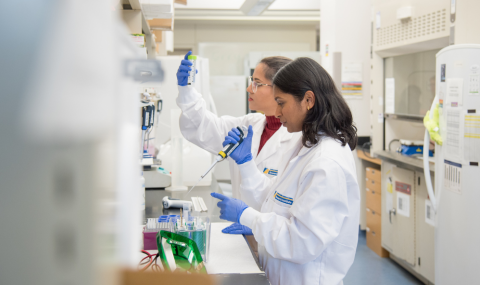"Blood Products" is a term used to describe products that contain any components of normal blood. When an individual donates a unit of the blood, the donation is usually "whole blood". A unit of whole blood can be broken down into many different products or blood components. Patient's canbe given just the part of the blood that they need, allowing many patients to benefit from one donation.
A CBC (Complete Blood Count) is a blood test that is performed very frequently in the critical care unit. It allows us to measure the amount and type of red and white blood cells and the number of platelets. A "blood smear" or "differential" (often called a "diff") is a detailed look at the CBC under a microscope. A differential provides information about the appearance of each type of cell and can be helpful in diagnosing many diseases.
Blood is divided into plasma (the water portion) and cells. About 45% of the volume of whole blood is made up of cells. White blood cells (also called leukocytes or WBCs) and platelets (also called thrombocytes) make up about 1% of the total cell volume (most of the cells are red).
White blood cells are an important part of our inflammatory response. Our white blood cell count is the total of the many different types of white blood cells. Neutrophils are one type of white blood cells. These are usually the first type to rise following acute inflammation (injury) or infection.
The white blood cell count can rise for many reasons. Inflammation will cause the total white blood cell count and the neutrophil count to increase (or even become very low). There are many possible causes for acute inflammation such as: trauma or injury (including surgery), low tissue oxygen levels (for or example after a stroke or heart attack) or the presence of foreign substances (including infection or cancer).Other diseases can also make the white blood cell count abnormal. Although the white blood cell count is an easy test to measure, the results must be interpreted with careful consideration of the patient's admission story and clinical situation.
Platelets are the cells that make up a clot. We make more platelets when we have an inflammatory response and use them up more quickly. Platelet counts can be high or low for all of the same reasons that a white blood cell count can change. A low platelets count can increase the risk for bleeding.
The remainder of the blood cells are red blood cells (called erythrocytes). Inside each red blood cell is approximately 300 hemoglobin molecules. Hemoglobin is a protein that carries oxygen. Each hemoglobin can carry 4 oxygen molecules. Red blood cells play a critical role in carrying oxygen from the lung to the tissues. When the red blood cells reach the organs and tissues, the hemoglobin molecule will release some of the oxygen to allow it to move into the cells as needed. A low hemoglobin level indicates that the red blood cell count is low, and is called anemia.
Mild anemia is common in critically ill patients. Bleeding and lab testing can cause a loss of hemoglobin. Red blood cells may not live as long during serious illness, and it is harder to make new ones. We can generally tolerate anemia well, however, severe anemia may make it harder to carry enough oxygen to the tissues. We may need to treat anemia with a transfusion of red blood cells when a patient is in shock, if the anemia is severe or if the patient is actively bleeding.
Although blood transfusions are very safe in Canada, there is always a very small chance of passing a virus from a donor to a recipient. Some blood products undergoing processing that reduces this small risk even further. Even though the risk is extremely low, we are careful to only give blood products when they are absolutely needed.
When a patient is admitted to CCTC, one of our physicians will speak to the patient or the patient's substitute decision-maker to obtain consent (or refusal) to receive blood products if needed. The physician will explain the risks during this discussion. Please ask us if you have any questions.
Before a blood transfusion is given, the patient and donor blood are checked carefully to make sure the blood type can be accepted by the patient.
Following blood donation, the red blood cells are removed from the donated blood and stored as a unit of "packed red cells" (or packed cells). Packed cells are given to increase the hemoglobin and red blood cell level. They do not contain plasma. A preservative is added to prevent the blood from clotting.
The plasma that is separated from a blood donation can be used for a number of purposes. Plasma contains proteins called clotting factors (or coagulation factors). These proteins are needed to make blood clot. We can give a patient a transfusion of Plasma if the blood is not clotting properly.
Whole blood also contains platelets. Platelets are the cells that stick together to help form a clot. Platelets are usually removed from donated plasma and stored separately. This allows more than one patient to benefit from a donated sample. One unit of donated blood can be used to give red blood cells to one patient, clotting factors to another and some platelets to a third.
When a patient needs a platelet transfusion, one unit of donated blood will not usually provide enough platelets. Therefore, the platelets from several donations are "pooled" or combined to give the patient an adequate dose. Platelets may need to be given if the patient has a very low platelet count and is at risk for bleeding.
Patients who are bleeding heavily may need a "massive transfusion". When we give a lot of blood products to one patient, we will given them red blood cells with plasma and platelets to try to replace all of their blood products.



